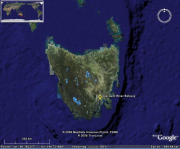Biosphere | Zoology | Crustaceans
Type of resources
Topics
Keywords
Contact for the resource
Provided by
Years
-
Interactions between native and introduced species can help to elucidate the impact of exotic species on the broader community. This work examines utilisation of an introduced gastropod, the New Zealand screwshell (Maoricolpus roseus) by native hermit crabs in eastern Tasmania.
-

Reef Life Survey is a program that trains and assists a network of skilled and committed recreational divers to cost-effectively assess the state of the inshore marine environment at the continental scale. The program uses standardised underwater visual census methods employed by SCUBA divers to survey fish and invertebrate species and to record macroalgal and coral cover using photo quadrats - this record refers to the website for this program. By standardising techniques and establishing a monitoring system on a nation-wide scale, the program addresses many of the current problems associated with managing the marine environment, including the paucity, patchiness and variable quality of data on the distribution of and trends to marine biodiversity. A central database is managed for the storage, analysis and dissemination of data collected nationally, with a publicly-accessible web-based portal. The website allows information collected on Australia's marine environment to be accessed in a meaningful form by policy-makers and the general public, including recreational groups, scientists and industry. It also has information and resources for particpating divers and those wishing to become involved. The dataset generated by recreational divers will provide a national framework for monitoring the state of the inshore environment and the identification of those threats and locations of greatest conservation concern. This record points to the online resource for Reef Life Survey: http://www.reeflifesurvey.com/
-
Interactions between native and introduced species can help to elucidate the impact of exotic species on the broader community. This work examines utilisation of an introduced gastropod, the New Zealand screwshell (Maoricolpus roseus) by native hermit crabs in eastern Tasmania. Variation in shell occupancy by hermit crabs was examined across different depths (10, 20, 30 and 40m) within a single site (Dennes Point, SE Tasmania). Sediment cores were taken from 10 and 20 m to compare sediment size structure. A sediment preference trial using the hermit crab Paguristes tuberculatus was also carried out (using sediment from 10m and 20m) to try and determine the low level of hermit crab occupancy at 20m (compared with that at 10m).
-
Interactions between native and introduced species can help to elucidate the impact of exotic species on the broader community. This work examines utilisation of an introduced gastropod, the New Zealand screwshell (Maoricolpus roseus) by native hermit crabs in eastern Tasmania. Samples of screwshells were collected from Bass Strait, Maria Island, Pirates Bay and Dennes Point using a modified scallop dredge or collected by divers. Site location, date, depth, dredge opening size were recorded, and random sub-samples of shells were measured for length and width, and spire damage was scored. Hermit crabs, if present, were identified to species, sexed and measured.
-
Saltmarshes and other coastal, salt-affected sites were sampled at 63 sites selected to cover the full range of saltmarsh types from all around the Tasmanian coast and on King and Flinders Islands. Sampling was conducted within each of the three saltmarsh zones. A faunal survey was conducted to measure the distribution of crustaceans and molluscs in relation to flora and soil conditions.
-

This study reports on previously undescribed predation on Asterias amurensis in the Derwent Estuary, Tasmania by the spider crab Leptomithrax gaimardii (Milne Edwards). Specifically, this study describes the predatory interaction between the spider crab and A. amurensis and quantifies patterns of sub-lethal injuries inflicted on the seastar during a localised aggregation of the spider crab.
-
A comparison was made of sediments and associated macrobenthos at sites sampled within 42 fish farm leases distributed across Tasmania. Several key biotic and abiotic metrics recommended in previous studies for assessing environmental impacts of fish farm waste were investigated.
 IMAS Metadata Catalogue
IMAS Metadata Catalogue